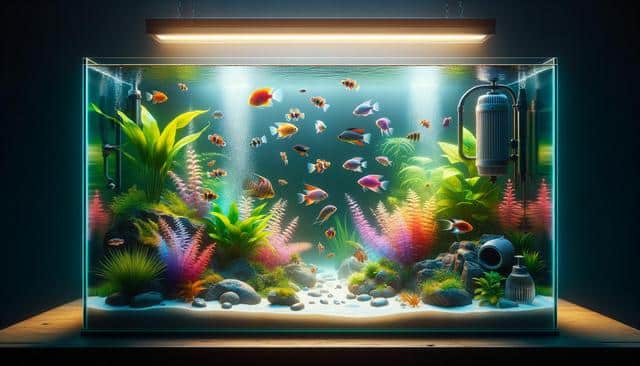A Beginner’s Guide to Setting Up a Tropical Fish Tank
Set up your first tropical fish tank with ease using this beginner’s guide. Learn about choosing the right tank, water conditions, filters, and fish species to create a vibrant, healthy aquatic environment you’ll enjoy watching every day.

Choosing the Right Tank and Equipment
Starting your tropical fish journey begins with selecting the right size tank. For beginners, a 20 to 30-gallon tank is often recommended because it offers more stable water conditions, which are easier to manage. Smaller tanks may seem convenient, but they can lead to rapid water quality changes that are harder to control. When selecting a tank, also consider the space where it will be placed. Avoid locations near direct sunlight or drafts, as these can affect water temperature. In addition to the tank, you’ll need several key pieces of equipment to ensure a healthy environment for your fish:
- Aquarium heater to maintain stable tropical temperatures (typically between 74°F and 80°F)
- Reliable water filter to keep the water clean and clear
- Lighting appropriate for both fish and any live plants
- Gravel or substrate, decorations, and hiding spots to create a comfortable habitat
Investing in a sturdy tank stand and a cover or hood will also help with safety and reduce evaporation. Take your time when choosing equipment to ensure it suits the needs of the species you plan to keep.
Understanding Water Conditions
Water quality is one of the most important aspects of maintaining a tropical aquarium. Before introducing any fish, it’s essential to cycle your tank. This process establishes beneficial bacteria that help break down waste products, making the environment safer for your aquatic pets. A properly cycled tank prevents the buildup of ammonia and nitrites, which can be harmful or fatal to fish.
Key water parameters to monitor include:
- Temperature: Keep it consistent within the tropical range
- pH level: Most tropical fish do well in a pH range of 6.5 to 7.5
- Ammonia, nitrite, and nitrate levels: Use a test kit to monitor these regularly
To maintain these conditions, regular water changes (about 25% weekly) are necessary. Use a water conditioner to neutralize chlorine and chloramines in tap water before adding it to the tank. Having a quality test kit on hand is crucial for tracking your tank’s health and ensuring a safe environment for your fish.
Selecting Tropical Fish for Beginners
When you’re new to tropical fishkeeping, it’s important to choose species that are hardy, peaceful, and compatible with each other. Avoid overcrowding the tank, as this can lead to stress and poor water quality. Instead, start with a small group of easy-to-care-for fish, and gradually add more once the tank is stable.
Some tropical fish species well-suited for beginners include:
- Livebearers such as guppies and platies
- Schooling fish like neon tetras or zebra danios
- Bottom-dwellers like corydoras catfish
- Algae eaters such as otocinclus or bristlenose plecos
These fish are generally peaceful and adapt well to community tanks. Be sure to research each species’ adult size, dietary needs, and habitat preferences to ensure compatibility. Avoid mixing aggressive species with peaceful ones, and always introduce new fish slowly to minimize stress.
Feeding and General Care
Feeding tropical fish is relatively simple, but consistency and moderation are key. Overfeeding can lead to poor water quality due to uneaten food and excess waste. Feed your fish once or twice a day, providing only as much as they can consume within a couple of minutes. Use a quality flake or pellet food designed for tropical fish, and supplement with occasional treats like frozen or freeze-dried bloodworms, brine shrimp, or vegetables depending on the species.
General care also includes routine tank maintenance tasks such as:
- Checking water parameters weekly
- Performing partial water changes
- Cleaning the substrate using a gravel vacuum
- Rinsing filter media in tank water (not tap water) to preserve beneficial bacteria
Observing your fish daily is also important. Watch for signs of illness such as unusual swimming patterns, spots, or changes in behavior. Early detection can help prevent issues from spreading. Keeping a maintenance schedule can help you stay on top of tasks and ensure your aquarium remains a healthy environment.
Decorating and Creating a Natural Habitat
A well-decorated tank not only looks attractive but also provides enrichment and comfort for your fish. Start with a layer of substrate on the bottom, such as gravel or sand, depending on the species you keep. Add decorations like rocks, caves, and driftwood to create hiding spots and territories, which are especially important in community tanks to reduce stress and aggression.
Live plants are a great addition to tropical tanks. They help improve water quality by absorbing excess nutrients and also provide shelter and breeding grounds for fish. Some easy-to-care-for plant options include:
- Anubias
- Java fern
- Amazon sword
- Hornwort
When designing your tank, consider the natural habitat of your fish. Mimicking their environment with appropriate lighting, plant cover, and swimming space can promote natural behaviors and overall well-being. Avoid overcrowding with decorations, as open swimming areas are also important. Balance aesthetics with functionality to create a thriving underwater ecosystem.
Conclusion: Starting Strong with Your First Tropical Tank
Setting up a tropical fish tank as a beginner doesn’t have to be overwhelming. By focusing on proper tank size, equipment, water quality, and species selection, you can create a stable and enjoyable environment for your fish. Regular maintenance and observation will help you catch issues early and keep your aquarium in top condition. As you gain experience, you may find yourself exploring new species, aquascaping techniques, and even breeding opportunities. With patience and care, a tropical fish tank can become a rewarding and relaxing part of your daily life.